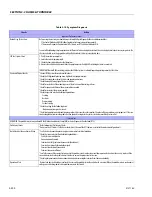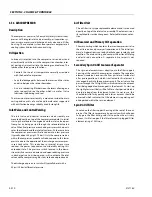
SECTION 3 - CHASSIS & TURNTABLE
3-212
3121160
Minimum Pressure Valve/Check Valve Assembly
This combined valve located in the filter support housing has
two functions.
The Minimum Pressure Valve - will maintain a pressure of
approximately 65
psig (4.5 bar) in the compressor unit to
ensure oil injection during load conditions and also to main-
tain effective oil separation. Once this internal pressure
is
exceeded it will allow air to discharge downstream to the ser-
vice outlet.
The Discharge Check Valve - prevents air in service lines or
downstream receiver from venting down through the com-
pressor during unload (when the compressor automatically
will unload to approximately 40 psig [2.75 bar] internally) and
also during shutdown.
Hydraulic Drive System
Scope of supply may vary depending upon customer specifi-
cations.
Hydraulic pump, oil reservoir, return line oil filter and hoses to
and from the completed packaged compressor are not fur-
nished with the compressor. This is customer responsibility.
The packaged compressor unit will normally contain the
hydraulic motor, hydraulic pressure relief valve, and on/off
solenoid valve.
Input hydraulic oil pressure feed is connected to the bulkhead
provided on the compressor package. Within the package the
high pressure oil feeds to a manifold containing the pressure
relief valve and directional solenoid valve. If a malfunction in
the hydraulic motor/compressor assembly causes the hydrau-
lic pressure to rise it will bypass to the return line to safeguard
damage or potential injury.
The directional solenoid valve is normally activated by the on/
off selector switch mounted in the instrument cluster on the
package, this valve is also connected through the compressor
safety circuits for over-temperature and over-pressure, if either
condition occurs it will shut the unit down, by diverting oil
back to tank. It is possible to add remote on/off switch in paral-
lel with the instrument cluster to permit on/off operation from
another location on the vehicle.
Hydraulic oil from the manifold is hosed directly to the hydrau-
lic motor and the outlet from the motor passes to the return
line connection on the package. Customer to provide both
hydraulic feed and return lines.
The hydraulic motor powers the compressor through a belt
drive system.
Compressor Cooling System
The package contains a cooler assembly powered by a 12 volt
D.C. electric fan. Oil from the compressor sump passes
through this cooler before being filtered for re-injection into
the compressor. A thermostatic fan temperature switch acti-
vates the fan to come on/off to maintain the correct operating
temperature for the compressor oil. This switch will activate
the fan to come on at approximately 185°F (85°C) and will
switch off again at approximately 165°F (74°C). The purpose of
maintaining an elevated temperature during operation is to
keep intake air moisture in suspension as it passes through the
compressor. Thermal switch activation is affected by ambient
conditions, load/unload cycles (or low oil level).
Initial Startup
The following procedure should be used to make the initial
start-up of your compressor:
1.
Position the compressor on a level surface so that the
proper amounts of oil can be added if required.
2.
Unit should be bolted down, do not rely on hoses to
hold the module in position.
3.
Check all hose connections are tight and wiring connec-
tions correct and tight.
4.
Check compressor oil level, top up if necessary.
5.
Switch instrument panel to OFF.
6.
Ensure hydraulic oil to pump inlet. (Prime if necessary)
7.
Engage hydraulic system and allow hydraulic oil to circu-
late back to tank. Check for leaks.
8.
Service valve on compressor closed.
9.
Switch the instrument panel switch to ON, this should
very quickly pass oil to the hydraulic motor on the com-
pressor and start producing air.
10.
Check pressure and temperature gauges. Pressure
switch may need adjustment to achieve desired operat-
ing pressure.
11.
Partly open service valve to load compressor and allow
to warm up. Monitor temperature gauge, the ideal oper-
ating temperature should be between 165°F and 190°F
(74°C and 88°C) although it may be higher in high ambi-
ent conditions.
12.
Cycle compressor on/off with service valve to ensure
operation is OK
13.
Close service valve then switch instrument switch to
OFF.
14.
Disengage hydraulic system.
Summary of Contents for 740AJ
Page 2: ......
Page 55: ...SECTION 3 CHASSIS TURNTABLE 3121160 3 3 This page left blank intentionally...
Page 116: ...SECTION 3 CHASSIS TURNTABLE 3 64 3121160 Figure 3 44 Swing Hub Prior to SN 0300074383...
Page 203: ...SECTION 3 CHASSIS TURNTABLE 3121160 3 151 Figure 3 77 EFI Component Location...
Page 206: ...SECTION 3 CHASSIS TURNTABLE 3 154 3121160 Figure 3 78 ECM EPM Identification ECM EPM...
Page 224: ...SECTION 3 CHASSIS TURNTABLE 3 172 3121160 Figure 3 83 Deutz EMR 2 Troubleshooting Flow Chart...
Page 228: ...SECTION 3 CHASSIS TURNTABLE 3 176 3121160 Figure 3 87 EMR 2 Engine Plug Pin Identification...
Page 229: ...SECTION 3 CHASSIS TURNTABLE 3121160 3 177 Figure 3 88 EMR 2 Vehicle Plug Pin Identification...
Page 230: ...SECTION 3 CHASSIS TURNTABLE 3 178 3121160 Figure 3 89 EMR2 Fault Codes Sheet 1 of 5...
Page 231: ...SECTION 3 CHASSIS TURNTABLE 3121160 3 179 Figure 3 90 EMR2 Fault Codes Sheet 2 of 5...
Page 232: ...SECTION 3 CHASSIS TURNTABLE 3 180 3121160 Figure 3 91 EMR2 Fault Codes Sheet 3 of 5...
Page 233: ...SECTION 3 CHASSIS TURNTABLE 3121160 3 181 Figure 3 92 EMR2 Fault Codes Sheet 4 of 5...
Page 234: ...SECTION 3 CHASSIS TURNTABLE 3 182 3121160 Figure 3 93 EMR2 Fault Codes Sheet 5 of 5...
Page 303: ...SECTION 4 BOOM PLATFORM 3121160 4 31 Figure 4 20 Rotator Assembly HELAC...
Page 460: ...SECTION 5 BASIC HYDRAULIC INFORMATION AND SCHEMATICS 5 116 3121160 NOTES...
Page 467: ...SECTION 6 JLG CONTROL SYSTEM 3121160 6 7 Figure 6 2 ADE Block Diagram...
Page 534: ...SECTION 6 JLG CONTROL SYSTEM 6 74 3121160 NOTES...
Page 580: ...SECTION 7 BASIC ELECTRICAL INFORMATION SCHEMATICS 7 46 3121160 NOTES...
Page 581: ......








































